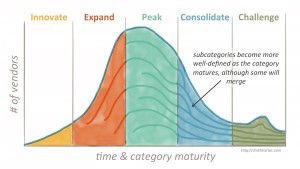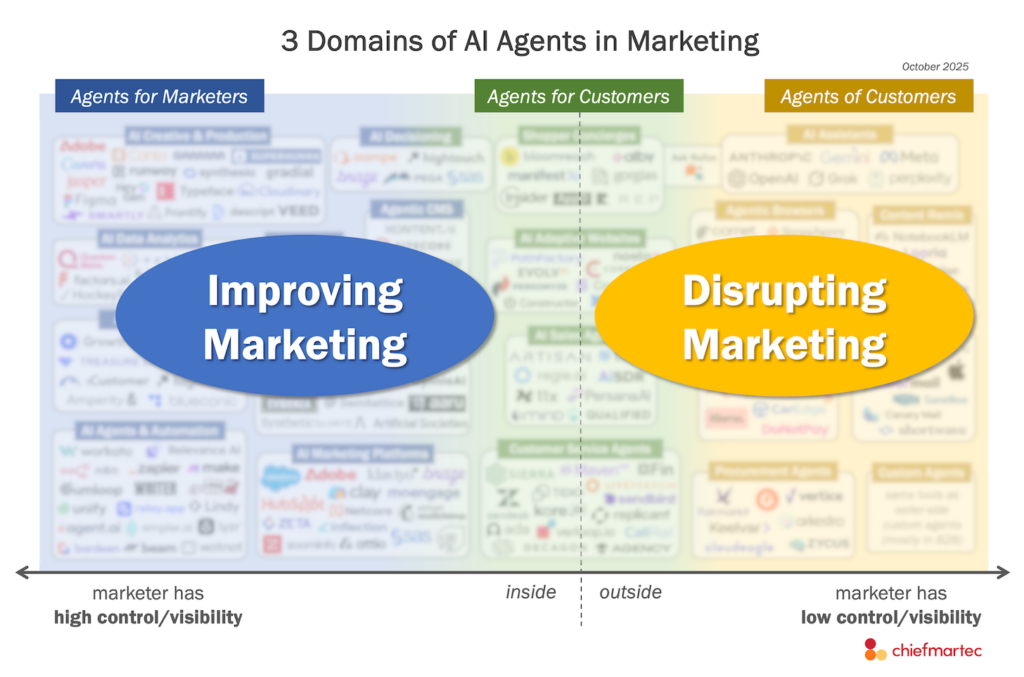Al Ries and Jack Trout, who essentially invented the concept of “positioning” in marketing, wrote a terrific book in 1993 called The 22 Immutable Laws of Marketing. It’s a fantastic read, and even though it’s more than two decades old, I believe it’s as relevant today as ever.
To discuss marketing technology consolidation, I’d like to call out six of their “immutable” laws related to positioning:
#1 The Law of Leadership: It is better to be first than it is to be better.
#2 The Law of Category: If you can’t be first in a category, set up a new category you can be first in.
#3 The Law of the Mind: It’s better to be first in the mind than to be first in the market.
#4 The Law of Perception: Marketing is not a battle of products, it’s a battle of perceptions.
#8 The Law of Duality: In the long run, every market becomes a two horse race.
#10 The Law of Division: Over time, a category will divide and become two or more categories.
If we mash these together (with apologies to Ries and Trout), the simple conclusion is that almost every product category eventually converges to a “two horse race,” with a leading brand and a following brand. Maybe a third contender. The remaining competitors in the market have miniscule share in comparison, a long tail of niches that are mostly invisible to mainstream buyers — except for those competitors who are smart enough to create a new category and become a leading brand in it.
Is this the future of marketing technology?
Probably, yes — but with six important caveats that defy an oversimplified interpretation of consolidation across the industry.
First, “marketing technology” isn’t a category itself, but a large sector in which there are dozens to hundreds of categories, depending on how you slice it up. For instance, you could call “website content management systems” (CMS) a category. But more precisely, there are multiple categories within that space — enterprise systems available from companies like Adobe and Sitecore, small business platforms such as Squarespace and Wix, and open source platforms like WordPress and Drupal.
And new categories keep arriving at a pretty fast clip.
Second, when a category is young — as many of the categories in marketing tech still are — there can be many competitors with similar levels of market share and brand awareness. This primarily happens during the Innovate, Expand, and Peak phases described in the 5 stages of maturity in marketing technology categories.
What about the “it’s better to be first than it is to be better” law? Shouldn’t the early players in a category win on that principle? Not necessarily. That dynamic actually relies heavily on the law about being first in the mind.
Most vendors in emerging marketing technology categories are simply not known by many people at all — mainstream marketers’ minds are a mostly blank (or muddled) slate when it comes to such new categories. Nobody is “first in the mind” at scale yet.
Frankly, most of those category start-ups don’t have the marketing war chest necessary to blanket their brand across the industry to quickly become “first in the mind” on a wide basis. Instead, they win a deal at a time and incrementally build awareness — and their competitors do the same. It takes a lot of persistence and continuously strong execution over years to achieve escape velocity. Sprinklr strikes me as a good example of this in the enterprise social relationship platform space — they’re breaking through as a top brand, but that took a lot of work over many years.
You can tell that a category is moving into the Consolidate phase when you ask 10 marketers who the top vendors are in the space and you mostly get the same 3-4 answers from everyone.
Once you reach that tipping point, things accelerate for the leading brands due to a positive feedback loop: new buyers want to purchase from the best known brands, which makes those brands even better known, and so on. We see this with the leading CRM, CMS, and marketing automation (MAP) brands today.
Third, it’s debatable whether or not “marketing clouds” will constitute a super-category that collapses every other category. My sense is that the marketing clouds are competing more for the “backbone platform” position in marketers’ minds, or winning on individual pieces of their portfolios (e.g., Adobe Experience Manager, Oracle Eloqua, Salesforce CRM). Many marketers — at least at mid-size and enterprise companies — still want best-of-breed choices for more specialized martech categories.
I continue to believe that this is an opportunity that most marketing cloud contenders have yet to fully exploit. It’s really hard to maintain a brand that “does it all” in the mind of a buyer in such a diverse and evolving space as marketing.
There are a couple of possible exceptions to this in my opinion.
1) Adobe, as they are “first in the mind” for software for marketers in many contexts, predating pretty much everyone else in the industry. However, I don’t think this is justification of a well-defined super-category of marketing clouds — which are very amorphous beasts — but rather that Adobe is a brand that spans multiple categories across the marketing industry overall.
2) HubSpot, followed by Act-On and Infusionsoft, as all-in-one marketing solutions for small, non-technical businesses. Don’t get me wrong — these vendors also compete beyond that segment. But with larger or more technical customers they are more likely to be part of a best-of-breed solution. So this is really a “small business marketing cloud” category, a qualitatively different category than the Adobe and Oracle clouds.
In all segments, however, new entrants to the marketing cloud category (or categories) face an uphill marketing battle, as the brands that are associated with that phrase are well-embedded in many people’s minds now. My humble advice to would-be cloud conquerers: define your offering as a different category (e.g., “marketing operating system”).
Fourth, service providers tend to live in different categories than pure marketing tech vendors — but can powerfully compete as substitutes. Major marketing service providers such as Alliance Data, Axciom, Experian, and Merkle may not be “first in the mind” as marketing technology vendors. But they have competitive technology solutions that serve many of the same needs. They come in through a different mental door into the CMO’s office, but they effectively compete with marketing technology vendors through a different category lens.
Fifth, many vendors continue to develop features beyond their core category into adjacent categories and deploy them into their existing customer base — also short-circuiting brand competition in well-defined categories. For example, you might not think of CallidusCloud as a leading marketing automation brand. But they are a top sales performance management brand that is expanding their offerings into marketing automation. They will have a tough climb to establish themselves as a stand-alone marketing automation brand — not impossible, but hard given the head start that so many other brands have in marketers’ minds — but for customers who buy them as a sales effectiveness brand, they have a reasonable shot at expanding into marketing automation inside those accounts.
Sixth, even when a small number of brands pull away from the crowd, smaller and niche marketing tech vendors will continue to exist for a long time. We live in a world where — primarily due to open source and infrastructure-as-a-serivce (IaaS) — it’s really inexpensive to build and maintain sotware. There will always be small martech companies willing to try new things and innovate in ways that differ from the major brands. And there will always be customers who like to work with those small companies because they have much more leverage with those vendors to get exactly what they want. If you wrap services around those niche martech products, they can be quite sustainable.
Of course, these niche players will have almost no hope of achieving $100 million+ scale in the face of a category dominated by major brands. But that doesn’t mean they won’t be viable $10-30 million businesses that make their owners, employees, and customers happy. And a few will find ways to invent new categories that they pivot to and become a leading brand of.
But these are caveats.
The core challenge for every marketing technology vendor, if you buy into the Ries-Trout view of positioning, which I mostly do, is: what category are you in and how can you be the #1 or #2 brand in it as it matures?






First of all, thanks so much for putting out this great article!
Open Source has proven time and again that it can lever out the immutable laws, especially #1 and #2. Then again, as an open-source player, you better make sure you are in line with #1 and #2 to be able to compete against a proprietary first mover in an existing category.
Having said the above, we today see that new Open Source products are not just a follower in a market, but are highly innovative and establish new categories (Docker, Ceph). Plus, Open Source is not anymore just about the lower levels in the technology stack.
This all results in hybrid open source business models where the code is accessible to any developer, the product can be utilized easily by end users as a cloud service and a marketplace of modules leverages community contributions.
We’re just at the start of Open Source shaking up the martech space, especially now that it increasingly gets VC attention: http://venturebeat.com/2015/12/06/its-actually-open-source-software-thats-eating-the-world/
Competition is very tough these days especially in the online business. And you have to do something about is so you won’t loose the game. Yes, it’s always a game and you need to have good strategies to able to win it. That’s what you need to have, a good strategy. And technology has a lot to offer so you’ll continue the race to meet your goal and attain success.